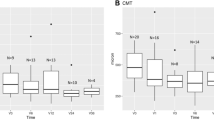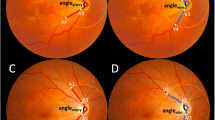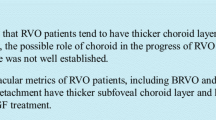Abstract
Purpose
To assess the visual outcome and prognostic factors after surgery for a secondary epiretinal membrane (ERM) due to branch retinal vein occlusion (BRVO).
Methods
Medical records of 33 patients (33 eyes) were retrospectively reviewed. All patients underwent vitrectomy and completed at least one year of follow-up. Patients characteristics, including baseline best-corrected visual acuity (BCVA; logMAR, logarithm of the minimum angle resolution), fluorescein angiography and optical coherence tomography findings were analyzed.
Results
Twenty eyes (60.6%) were non-ischemic and nine eyes (27.3%) had ischemic maculopathy. The mean BCVA was 0.82 ±0.56 logMAR (20/132 Snellen equivalent) at baseline and 0.43 ±0.37 logMAR (20/53 Snellen equivalent) at 1 year (p = 0.001). At 1 year three eyes (9.1%) had visual loss with 0.3 logMAR or more deterioration than baseline whereas 16 eyes (48.5%) gained vision. The mean central macular thickness (CMT) was 407.3 ±138.8 μm at baseline and 274.71 ±40.5 μm at 1 year after surgery (p = 0.001). Photoreceptor integrity was intact in 20 eyes (60.6%). Photoreceptor integrity (B = 0.248, p = 0.001) at baseline was significantly correlated with visual outcome after surgery.
Conclusion
Surgery for a secondary ERM associated with BRVO led to a relatively favorable visual outcome. The integrity of photoreceptors at baseline seems to be useful in predicting visual outcome in these patients.




Similar content being viewed by others
References
Klein R, Klein BE, Moss SE, Meuer SM (2000) The epidemiology of retinal vein occlusion: the Beaver Dam Eye Study. Trans Am Ophthalmol Soc 98:133–141
Rehak J, Rehak M (2008) Branch retinal vein occlusion: pathogenesis, visual prognosis, and treatment modalities. Curr Eye Res 33:111–131
Jaulim A, Ahmed B, Khanam T, Chatziralli IP (2013) Branch retinal vein occlusion. Epidemiology, pathogenesis, risk factors, clinical features, diagnosis, and complications. An update of the literature. Retina 33:901–910
Mitchell P, Smith W, Chang A (1996) Prevalence and associations of retinal vein occlusion in Australia. The Blue Mountains Eye Study. Arch Ophthalmol 114:1243–1247
Wong TY, Scott IU (2010) Clinical practice. Retinal vein occlusion. N Eng J Med 363:2135–2144
Lang GE, Freissler K (1992) Clinical and fluorescein angiography findings in patients with retinal vein occlusion. A unicenter study of 211 patients. Klin Monbl Augenheilkd 201:234–239
Shilling JS, Kohner EM (1976) New vessel formation in retinal branch vein occlusion. Br J Ophthalmol 60:810–815
Singh M, Dhir L, Kon C, Rassam S (2006) Tractional retinal break and rhegmatogenous retinal detachment consequent to branch retinal vein occlusion. Eye 20:1326–1327
Apostolopoulos M, Koutsandrea C, Chatjoulis D, Ladas J, Theodossiadis G (1995–1996) Late complications in branch retinal vein occlusion. Int Ophthalmol 19:281–285
Takahashi M, Hirokawa H, Trempe CL (1981) Vitreous detachment, neovascularization, and vitreous hemorrhage in retinal branch vein occlusion. Nihon Ganka Gakkai Zasshi 85:731–736
Mitchell P, Smith W, Chey T, Wang JJ, Chang A (1997) Prevalence and associations of epiretinal membranes. The Blue Mountains Eye Study, Australia. Ophthalmology 10:1033–1040
Amirikia A, Scott IU, Murray TG, Flynn HW Jr, Smiddy WE, Feuer WJ (2001) Outcomes of vitreoretinal surgery for complications of branch retinal vein occlusion. Ophthalmology 108:372–376
Hvarfner C, Andreasson S, Larsson J (2006) Multifocal electroretinography and fluorescein angiography in retinal vein occlusion. Retina 26:292–296
Puliafito CA, Hee MR, Lin CP, Reichel E, Schuman JS, Duker JS, Izatt JA, Swanson EA, Fujimoto JG (1995) Imaging of macular diseases with optical coherence tomography. Ophthalmology 102:217–229
Kang HM, Chung EJ, Kim YM, Koh HJ (2013) Spectral-domain optical coherence tomography (SD-OCT) patterns and response to intravitreal bevacizumab therapy in macular edema associated with branch retinal vein occlusion. Graefes Arch Clin Exp Ophthalmol 251:501–508
Suh MH, Seo JM, Park KH, Yu HG (2009) Associations between macular findings by optical coherence tomography and visual outcomes after epiretinal membrane removal. Am J Ophthalmol 147:473–480
Inoue M, Morita S, Watanabe Y, Kaneko T, Yamane S, Kobayashi S, Arakawa A, Kadonosono K (2010) Inner segment/outer segment junction assessed by spectral-domain optical coherence tomography in patients with idiopathic epiretinal membrane. Am J Ophthalmol 150:834–839
Mitamura Y, Hirano K, Baba T, Yamamoto S (2009) Correlation of visual recovery with presence of photoreceptor inner/outer segment junction in optical coherence images after epiretinal surgery. Br J Ophthalmol 93:171–175
Kim JH, Kim YM, Chung EJ, Lee SY, Koh HJ (2012) Structural and functional predictors of visual outcome of epiretinal membrane surgery. Am J Ophthalmol 153:103–110
Branch Vein Occlusion Study Group (1986) Argon laser scatter photocoagulation for prevention of neovascularization and vitreous hemorrhage in branch retinal vein occlusion. A randomized clinical trial. Arch Ophthalmol 104:34–41
Oster SF, Mojana F, Brar M, Yuson RM, Cheng L, Freeman WR (2010) Disruption of the photoreceptor inner segment/outer segment layer on spectral domain-optical coherence tomography is a predictor of poor visual acuity in patients with epiretinal membranes. Retina 30:713–718
Falkner-Radler CI, Glittenberg C, Hagen S, Benesch T, Binder S (2010) Spectral-domain optical coherence tomography for monitoring epiretinal membrane surgery. Ophthalmology 117:798–805
Hiscott PS, Grierson I, McLeod D (1985) Natural history of fibrocellular epiretinal membranes: a quantitative, autoradiographic, and immunohistochemical study. Br J Ophthalmol 69:810–823
Bochaton-Piallat ML, Kapetanios AD, Donati G, Redard M, Gabbiani G, Pournaras CJ (2000) TGF-beta 1, TGF-beta receptor II and ED-A fibronectin expression in myofibroblast of vitreoretinopathy. Invest Ophthalmol Vis Sci 41:2336–2342
Harada C, Mitamura Y, Harada T (2006) The role of cytokines and trophic factors in epiretinal membranes: involvement of signal transduction in glial cells. Prog Retin Eye Res 25:149–164
Mori K, Gehlbach PL, Sano A, Deguchi T, Yoneya S (2004) Comparison of epiretinal membranes of differing pathogenesis using optical coherence tomography. Retina 24:57–62
Sakimoto S, Saito Y, Nakata K, Sakamoto Y, Tatebayashi M (2008) Surgical outcomes of epiretinal membrane removal after successful pars plana vitrectomy for retinal diseases. Jpn J Ophthalmol 52:227–230
Benichou C, Flament J (1989) (1989) Epiretinal membrane and photocoagulation with argon laser. Discussion of 3 cases. Bull Soc Ophtalmol Fr 89:613–619
Marticorena J, Romano MR, Heimann H, Stappler T, Gibran K, Groenewald C, Pearce I, Wong D (2011) Intravitreal bevacizumab for retinal vein occlusion and early growth of epiretinal membrane: a possible secondary effect? Br J Ophthalmol 95:391–395
Acknowledgments
Funding/support
none
Financial disclosure
none
Contributions of authors
Design and conduct of study (HM Kang); collection of data (HM Kang); management, analysis, and interpretation of data (HM Kang, HJ Koh, SC Lee); and preparation, review, and approval of the manuscript (HM Kang, HJ Koh, SC Lee).
Other acknowledgments
none
Author information
Authors and Affiliations
Corresponding author
Rights and permissions
About this article
Cite this article
Kang, H.M., Koh, H.J. & Lee, S.C. Visual outcome and prognostic factors after surgery for a secondary epiretinal membrane associated with branch retinal vein occlusion. Graefes Arch Clin Exp Ophthalmol 253, 543–550 (2015). https://doi.org/10.1007/s00417-014-2731-2
Received:
Revised:
Accepted:
Published:
Issue Date:
DOI: https://doi.org/10.1007/s00417-014-2731-2




